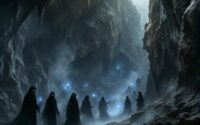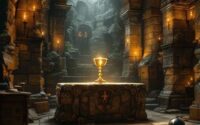The Sleeping Hero: King Arthur, Etc
The sleeping hero motif appears across countless cultures, but Britain’s King Arthur remains its most enduring example. He’s said to rest beneath Glastonbury Tor or in Welsh caves, awaiting his nation’s darkest hour. This ancient belief pattern extends beyond Arthur to figures like Brân the Blessed and Ireland’s Fionn mac Cumhaill. What drives societies to create these dormant saviors, and why do such legends persist into the modern age?
Introduction

When medieval chroniclers first put quill to parchment about King Arthur, they couldn’t have imagined their tales would captivate audiences for over a millennium. The legendary British king has transcended his origins as a possibly historical war leader to become mythology’s most enduring sleeping hero. Arthur’s story promises he’ll return when Britain needs him most, establishing the archetype of the rex quondam, rexque futurus—the once and future king.
This messianic narrative resonates across cultures, from Germany’s Frederick Barbarossa to Portugal’s Sebastian I. Each nation’s sleeping hero embodies collective hopes for deliverance during dark times. Arthur’s particular appeal lies in his dual nature: he’s both a flawed human ruler and a supernatural figure waiting in Avalon, bridging earthly governance with divine providence.
Celtic Mythological Sleeping Warrior Traditions
Before Arthur’s legend crystallized in medieval literature, Celtic mythology had already established a rich tradition of sleeping warriors awaiting their people’s greatest hour of need. The Welsh tale of Brân the Blessed describes Britain’s protector whose severed head continued guarding the island for eighty years. Irish mythology tells of Fionn mac Cumhaill, who sleeps beneath Dublin, ready to defend Ireland when summoned by the Dord Fiann horn.
These narratives share common elements: heroes don’t truly die but enter suspended animation in hidden locations—caves, hollow hills, or mystical islands. They’re accompanied by loyal warriors, maintaining their weapons and strength throughout centuries of slumber. The stories promise their return during apocalyptic threats, when ordinary defenses fail. This mythological pattern provided the foundation for Arthur’s eventual transformation into Britain’s eternal guardian.
Notable Cases or Sightings

Throughout centuries of British history, documented encounters with the sleeping Arthur have emerged from various locations, each adding credibility to the legend’s persistence. In 1113, French priests visiting Bodmin were reportedly attacked after denying Arthur’s return. Medieval chroniclers recorded shepherds discovering sleeping knights in Welsh caves, while nineteenth-century antiquarians collected testimonies from locals who’d stumbled upon hidden chambers beneath Cadbury Castle.
The most intriguing account comes from 1745, when a Somerset farmer claimed he’d found an iron door inside a hillside cavern. Behind it lay armored warriors surrounding a crowned figure on a stone throne. Similar reports surfaced near Alderley Edge in Cheshire and Craig-y-Ddinas in Wales. These sightings share consistent details: accidental discovery, sleeping knights, magical barriers, and witnesses who couldn’t relocate the entrances.
Common Theories or Explanations
While skeptics dismiss these sightings as folklore, scholars have proposed several theories to explain the sleeping Arthur phenomenon‘s endurance. Carl Jung’s collective unconscious theory suggests Arthur represents an archetypal hero figure embedded in humanity’s shared psyche. This explains why similar sleeping hero myths exist across cultures worldwide.
Political historians argue the legend served medieval monarchs’ legitimacy claims. By invoking Arthur’s eventual return, rulers positioned themselves as temporary stewards awaiting the true king’s awakening. This narrative justified their authority while offering hope during turbulent periods.
Anthropologists view the myth as society’s psychological coping mechanism. When facing invasion, plague, or political upheaval, communities found comfort believing their greatest hero wasn’t dead but merely waiting. The legend transforms death’s finality into temporary absence, making cultural trauma bearable.
Frequently Asked Questions
How Can I Visit Caves or Sites Associated With Sleeping Hero Legends?
Visitors can explore Glastonbury Tor and caves in Wales, Scotland’s Arthur’s Seat, and Germany’s Kyffhäuser mountain. They’ll find guided tours at major sites, while smaller locations require local research. Many sites offer historical interpretations year-round.
Are There Modern Books or Films Inspired by the Sleeping Hero Myth?
Yes, many modern works draw from this myth. Tolkien’s “Return of the King” features Aragorn’s sleeping army. Marvel’s “Captain America” shows a hero frozen in ice. Susan Cooper’s “The Dark Is Rising” sequence prominently features sleeping Arthur.
What Rituals or Ceremonies Are Performed at Sleeping Hero Sites Today?
Modern visitors leave offerings at Glastonbury Tor and perform solstice ceremonies. Pilgrims conduct vigils at Arthur’s supposed resting places. Neo-pagan groups hold seasonal rituals, while others practice meditation and prayer at these legendary sites.
How Do Different Religions View the Sleeping Hero Prophecies?
Different religions interpret sleeping hero prophecies uniquely. Christians often view them as secular legends or false messianic hopes. Muslims connect some to eschatological figures. Neopagans embrace them as sacred mysteries. Most mainstream faiths don’t officially recognize them.
Can DNA Testing Prove Connections Between Claimed Descendants and Legendary Heroes?
DNA testing can’t prove connections to legendary heroes since they’re mythical figures without verified remains or genetic samples. Scientists can’t compare modern DNA to nonexistent ancient profiles, making such genealogical claims scientifically impossible to verify.


